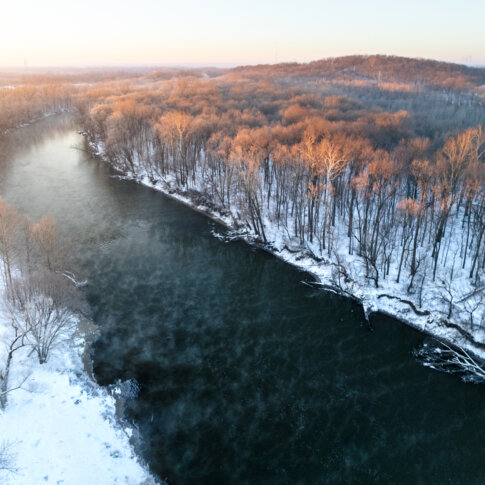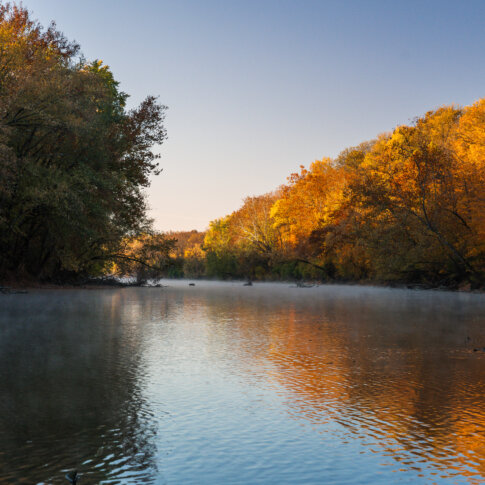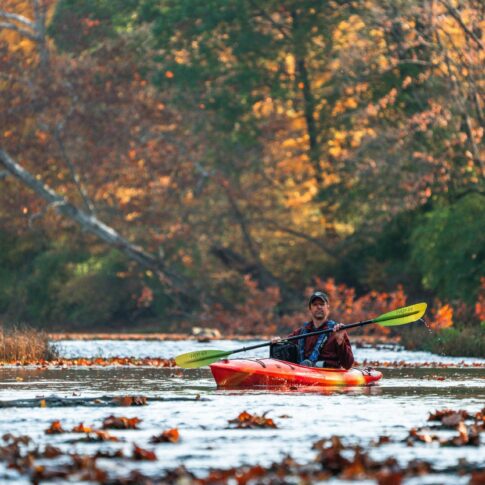Quiet Beauty Along the River As the air grows crisp and the river trails quiet, the White River invites you to greet winter in new ways. Nature lovers can bundle […]
Fishing
There’s a whole world to discover inbetween the banks.
Wonderful Waters
Fishing on the White River in central Indiana offers anglers a diverse and rewarding experience. With its calm waters, variety of surroundings, and accessible fishing spots, the White River offers opportunities for both experienced anglers and beginners looking to enjoy a day of fishing in the heart of Indiana.
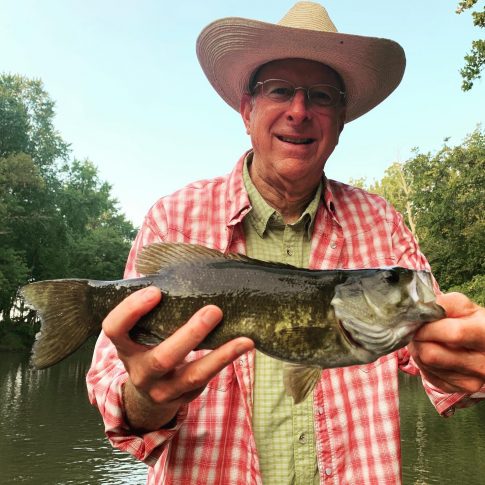
What’s in the River?
The White River in central Indiana is home to a variety of game fish species that attract anglers. Some of the common game fish species found in the White River in central Indiana include:
Smallmouth Bass
Smallmouth bass are known for their strong fighting ability and are a popular game fish in the White River. They can be found in rocky areas, near structures such as submerged logs, and in deeper pools of the river.
Largemouth Bass
Largemouth bass are another popular game fish in the White River. They can be found in various habitats such as weeds, submerged logs and near shoreline vegetation. Largemouth bass are known for their aggressive strikes and are often targeted by anglers for their size and fighting ability.
Channel Catfish
Channel catfish are abundant in the White River and are often targeted by anglers. They can be found in deeper pools, around structures such as logjams and near underwater cover. Channel catfish are known for their size and are prized for their taste.
Flathead Catfish
Flathead catfish, also known as yellow catfish, are another popular game fish species in the White River. They prefer deep pools with cover such as logs or submerged structures. Flathead catfish are known for their large size and can provide a thrilling angling experience.
Bluegill
Bluegill, also known as bream or sunfish, are a common panfish species found in the White River. They can be found near vegetation, submerged logs and other structures. Bluegill are popular targets for beginners and experienced anglers alike due to their abundance, willingness to bite and delicious taste.
Crappie
Black and white crappie are also present in the White River and are popular panfish species among anglers. They can be found around submerged structures such as fallen trees, brush piles and bridge piers. Crappie are known for their tasty filets and are often targeted for their size and abundance.
Carp
Carp are a common species found in the White River and can provide an exciting angling experience. Carp can be found in various habitats, including deeper pools and slower-moving sections of the river. They are known for their strong fighting ability and can grow to large sizes.
Boat Launches
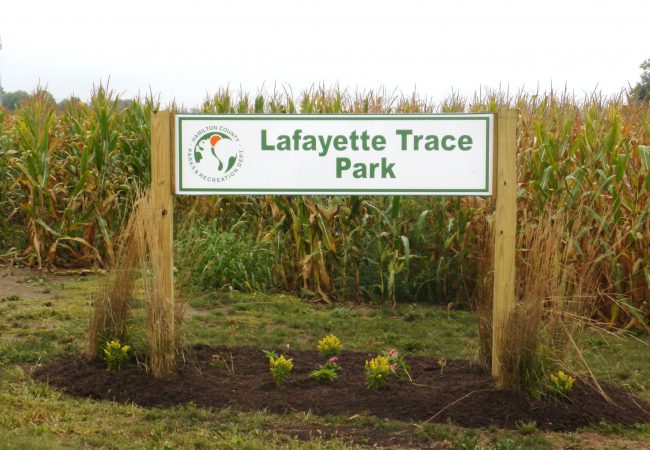
Lafayette Trace Park
Popular fishing and boating access spot.

Forest Park
Filled with attractions and activities, Forest Park is a destination for the entire family!
Broad Ripple Park
A dog park, outdoor pool, walking trails, great playgrounds for kids, and more all along the White River.

Riverside Park
Get active! Golf, launch a boat, enjoy the courts all within Riverside Park's 860+ acres.
Noblesville DNR Boat Ramp
Public access boat ramp next to Forest Park
Regulations
It’s important to check the current fishing regulations and any specific rules or restrictions that may apply to the White River or any other water body in Indiana before fishing for game fish. Size limits, catch limits, and other regulations may apply to certain species, and it’s the responsibility of anglers to comply with all applicable fishing regulations.
A license from the Indiana Department of Natural Resources is required for adults to fish, including in the White River. Children 17 and younger do not need a license. Licenses are available for a year as well as short-term periods of one day (for residents and non-residents) or one week (non-residents).
Fishing Licenses
Licenses can be purchased online or through a network of retailers. For adults, fees (as of 2023) are $23 per year or $10 per day for residents and $60 per year or $15 per day for non-residents.
Check the calendar for free fishing days.
Catch Limits
In any stream or river in Indiana, anglers are limited to 5 of any combination of largemouth, smallmouth or spotted bass. Of these, no fish 12 to 15 inches may be kept and no more than two over 15 inches may be kept.
Boating/Paddling Guidelines
If your fishing trip involves a watercraft, be sure to follow the regulations for paddling as well.
Other Fishing Regulations
Consult the Indiana Fishing Regulations Guide for complete regulations regarding fishing in Indiana.
It’s important to note that fishing regulations can change, and it’s the responsibility of anglers to be aware of and comply with the current fishing regulations in the White River or any other water body in Indiana. Anglers can obtain the most up-to-date and specific fishing regulations from the Indiana Department of Natural Resources (DNR) website, official fishing regulations publications, or by contacting the Indiana DNR directly.
Fish Consumption
Most waterways in Indiana have consumption advisories that vary based on the species of fish and who is eating them and even those that don’t fall under a general statewide guideline. According to the Indiana State Department of Health, the two contaminants that primarily drive consumption guidelines are mercury and PCBs, which are legacy industrial contaminants, as well as perfluorooctane sulfonate (PFOS), a more recent “forever chemical” used in things like waterproofing and firefighting foam. While these pollutants generally exist in very low levels, they can accumulate in fish tissue, and then human tissue, over time, causing problems. Guidelines are issued to keep this accumulation to safe levels.
Always refer to the Indiana State Department of Health for the most up-to-date information regarding consumption advisories for the White River or any waterway in Indiana.
North of Stony Creek in Noblesville
- Channel Catfish, Any Size: Do not eat
- Common Carp, Any Size: One meal/month
- Crappie, Any Size: One meal/week
- Largemouth Bass Under 16″: One meal/week
- Largemouth Bass Over 16″: One meal/month
- Smallmouth Bass, Any Size: One meal/month
- Sunfish, Any Size: One meal/week
- Other Species, Any Size: Refer to Statewide Guidelines
- Channel Catfish, Any Size: Do not eat
- Common Carp, Any Size: One meal/month
- Crappie, Any Size: One meal/week
- Largemouth Bass, Any Size: One meal/month
- Smallmouth Bass, Any Size: One meal/month
- Sunfish, Any Size: One meal/week
- Other Species, Any Size: One meal/month
* Sensitive population includes females under age 50 excluding women who are no longer capable of becoming pregnant, males underage 15, and people with compromised immune systems.
Stony Creek in Noblesville to Broad Ripple Dam in Indianapolis
- Channel Catfish Under 24″: One meal/month
- Channel Catfish Over 24″: Six meals/year
- Common Carp, Any Size: One meal/month
- Crappie, Any Size: One meal/week
- Largemouth Bass Under 16″: One meal/week
- Largemouth Bass Over 16″: One meal/month
- Smallmouth Bass, Any Size: One meal/month
- Sunfish, Any Size: One meal/week
- Other Species: Refer to Statewide Guidelines
- Channel Catfish Under 24″: One meal/month
- Channel Catfish Over 24″: Six meals/year
- Common Carp, Any Size: One meal/month
- Crappie, Any Size: One meal/week
- Largemouth Bass, Any Size: One meal/month
- Sunfish, Any Size: One meal/week
- Other Species, Any Size: One meal/month
* Sensitive population includes females under age 50 excluding women who are no longer capable of becoming pregnant, males underage 15, and people with compromised immune systems.
South of Broad Ripple Dam in Indianapolis
- Carpsucker, Any Size: One meal/month
- Channel Catfish, Any Size: One meal/month
- Common Carp, Any Size: One meal/month
- Crappie, Any Size: One meal/week
- Flathead Catfish, Under 23″: One meal/month
- Flathead Catfish, Over 23″: Six meals/month
- Freshwater Drum, Any Size: One meal/week
- Largemouth Bass, Under 10″: Unrestricted
- Largemouth Bass, Between 10″ and 15″: One meal/week
- Largemouth Bass Over 15″: One meal/month
- Redhorse, Any Size: One meal/month
- Rock Bass, Any Size: One meal/month
- Smallmouth Bass, Under 15″: One meal/week
- Smallmouth Bass, Over 15″: One meal/month
- Spotted Bass, Any Size: One meal/week
- Sunfish: Unrestricted
- Other Species: Refer to Statewide Guidelines
- Carpsucker, Any Size: One meal/month
- Channel Catfish, Any Size: One meal/month
- Common Carp, Any Size: One meal/month
- Crappie, Any Size: One meal/week
- Flathead Catfish, Under 23″: One meal/month
- Flathead Catfish, Over 23″: Six meals/month
- Freshwater Drum, Any Size: One meal/month
- Largemouth Bass, Under 15″: One meal/week
- Largemouth Bass Over 15″: One meal/month
- Redhorse, Any Size: One meal/month
- Rock Bass, Under 7″: One meal/week
- Rock Bass, Over 7″: One meal/month
- Smallmouth Bass, Under 15″: One meal/week
- Smallmouth Bass, Over 15″: One meal/month
- Spotted Bass, Any Size: One meal/month
- Sunfish: One meal/week
- Other Species: One meal/month
* Sensitive population includes females under age 50 excluding women who are no longer capable of becoming pregnant, males underage 15, and people with compromised immune systems.
Outfitters & Rentals

Two Forks Guide Service
Looking for an outstanding day on the river? Local fishing guides can help you enjoy a fully furnished, full-day experience of solitude and beauty on the river complete with insider knowledge on where the best fishing spots can be found.

Learn More
The White River is cleaner today than it has been in decades — and the progress underway is nothing short of historic. From massive underground tunnels to wetlands designed to […]
As summer fades and the air turns crisp, Central Indiana’s White Riverway transforms into a tapestry of color and celebration. The trees lining the river shine with shades of red, […]
